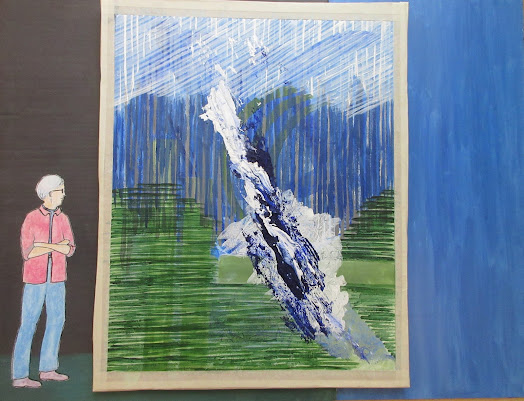Serendipitously, I'd already booked my 4-hour bus tour of the Capilano Watershed when my summer camp "Hydration" theme came to me. These tours are free but carefully controlled and managed as is Vancouver's water supply itself. I'd taken the tour most recently in 2023 and was very excited to travel back again into this protected zone. After that earlier trip, I'd used this scene at Palisade Creek as subject for a summer camp painting in the manner of Adirondack artist Levi Wells Prentice.
In the adventurous spirit of Summer Camp 2025, I'd also decided by this time to go out on a limb, like these watershed eagles.
The plan: While I continue to check out Hydration Locations, I'm going to investigate the unfamiliar territory of abstract art. Okay – I started with a deep browse into famed artist Gerhard Richter, still going strong at age 93, and getting a lot of publicity for recent exhibits. I must say I greatly prefer his "photo-realist" works, like "Reading" to his abstract with a capital "A"."
But it was very interesting to see this painting of his:
…and note its suggestion of woods and water, and similarity to the quick sketch I made as the watershed bus bumped along, with rocky streams visible through the roadside trees.
The very next week, sitting in the waiting room at my eye doctor's office, I appreciated, as always, the original works of art on the wall. (This seemed quite an innovative practice in the late 1970s, when I first saw the current doctor's predecessor-father). And as things were sliding along smoothly with my "Rough and Tumble" collage, I wasn't too surprised to see here another abstract painting that suggested flowing water and forest trees.
Onward now with the inspiration of the watershed! What most stayed with me from that trip was the concept of great cycles – and the many practical cycles that have been developed in the name of conservation. There's the reclaiming of wastewater – and the incredible "Track and Truck" program by which thousands of salmon are captured at the base of the impassable dam and transported to spawning grounds where eventually the small fry are transported back… Oh, but this is subject matter for someone else's blogs. Take a look at this YouTube mini-tour and you'll see some of the game-plan in action—as our tour group saw the cylindrical traps and specially rigged trucks by the side of the road.
Thinking about cycles didn't help me at all in the early stages of my painting.
But what did help was a memory that astonished me. For decades, I hadn't thought of it -- a passage I'd found in a book by Canadian author Timothy Findley. He cited it as a "hymn" from a work by Euripedes. It had been deeply meaningful to him as it was to me for the many years when we spent weekends and all our available time at a cabin in a mountain valley north of Vancouver. With the thought, I immediately recalled the whole piece from memory (although I've never found its exact source).
Earth the most great, and Heaven on high,
Father is he to man and god,
And she, who taketh to her sod
The cloud-flung rivers of the sky,
And beareth offspring –
Men and grass and beasts of all their kind,
Indeed, Mother of all and every seed.
Earth-gendered back to earth shall pass
And back to heaven the seeds of sky;
Seeing how all into all doth range,
And sundering, show new shapes of change,
And never that which is shall die.
With that, I plunged right in – covering up and then drawing out again, "Shapes of Change (Hydration Series)", copyright 2025.
My friend L (and luckily, I have a few of those – so don't point any fingers) said once, "I don't know much about art, but my real test is, 'Would I want to see this on my living room wall?'" Or maybe even, in full wall-size in the lobby of your nearest 5-star hotel?




















































